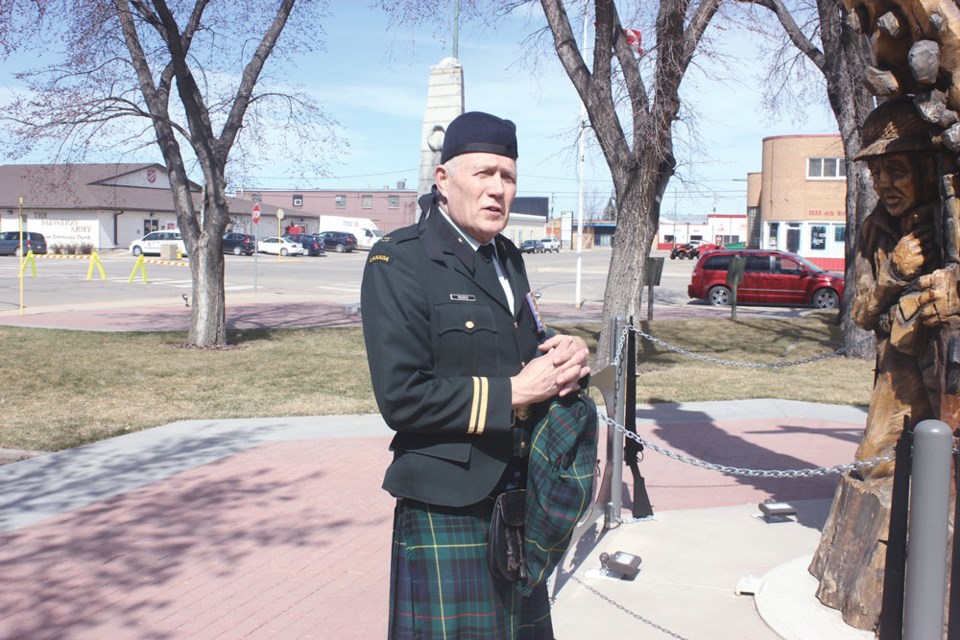Lieutenant Lester George Rooks was among 11 people from the Estevan area who was killed during the Battle of Vimy Ridge.
Seven more local soldiers died due to injuries sustained in the famous battle.
Canadians marked the 100th anniversary of the battle on April 9. But the day before, Estevan residents had the chance to commemorate the milestone anniversary, thanks to a series of events in the city hosted by the Estevan Army Cadets and the Estevan branch of the Royal Canadian Legion.
Lester Rooks’ nephew, Robert Rooks, spoke at the events about his uncle’s love for his country and his service during the war.
It was the first time Robert has shared his uncle’s story.
“It might get easier as time goes on, but it kind of tears at your heart,” Robert said in an interview with the Mercury.
Robert told the crowd his uncle signed up at the age of 20, shortly after Canada joined World War 1 in August 1918.
“There was a great enthusiasm to sign up and be part of this,” said Robert. “The thinking among young men at the time was that the war would be over by Christmas, and you if don’t hop on right away, you’ll miss the whole thing.”
Lester was an officer with the 20th Border Horse, a militia cavalry unit, at the start of the war.
“The story goes that when Lester got wind of the fact that war had broken out in Europe, he rode on his horse up the stairs into the front door, and into the beer parlor of the Empire Hotel in Estevan,” Robert said to laughs, “and announced to all of the startled patrons that war had been declared.”
Gibby’s Pub now occupies the building that used to house the Empire Hotel.
Lester was a partner in Rooks & Stokes business in Estevan at the time. He left his job as a watchmaker to join the war effort. He was also an avid hunter and outdoorsman who Robert said was part of every organization in town.
Through his research, Robert learned his uncle was an original member of Princess Patricia’s Canadian Light Infantry (PPCLI), even though the Patricias were filling their ranks with people in Ottawa, while Lester was in Estevan.
He believes Lester joined the PPCLI thanks to a train of ex-soldiers from Calgary who travelled to Ottawa and joined the regiment.
When the train stopped in Moose Jaw, a group of frontiersmen forced a CP Rail trainsmen to hitch an extra coach to the train. The train then headed to Ottawa.
“On August 24, 1914, Lester became No. 826 Private L.G. Rooks with the PPCLI,” said Robert.
Lester eventually became a member of the Royal Canadian Regiment, and remained until the Battle of Vimy Ridge.
Robert also read a letter that his uncle sent home, about a successful trench raid that preceded the Battle of Vimy Ridge. Lester sent it from London, while he was on 10 days of special leave.
“A trench raid is just a small battle, but all big battles are made up of small battles, so this trench raid gives you an idea of what went on when both sides are glaring each other in the eye,” said Robert.
Lester was at the helm of one of three groups of eight men who ventured down separate trenches to take prisoners. After a few days of planning and a box barrage, they executed the trench raid during the day to catch the Germans by surprise.
“The uproar from the artillery drowned everything else,” Lester wrote in the letter. “You could not hear yourself think.”
The Germans thought it was a suicide stunt, but the Canadians had plotted out the trench raid.
“We jumped off at 7:30 a.m., and reached the trenches without any trouble,” Lester wrote. “The wire was well cut, and when we got there, we had them napping, just as we had figured. Our men were the best that could be. They were just perfect and things went swimmingly.
“The artillery put on the barrage just to the minute, and we had Fritz (the Germans) at our mercy.”
They captured five Germans, killed 13 in the trenches and bombed 15 dugouts.
“The hardest part of the whole deal was to pick two men out of my party for decorations,” Lester wrote. “They were all so good, but I had to recommend two, because they could not all get it.”
Robert noted his uncle went through a lot by the date of the Battle of Vimy Ridge. He had seen action, led a trench raid, been in hospital with a lung infection and had his foot run over by a tractor.
He was a member of the Royal Canadian Regiment, as part of the 7th Brigade.
“At 5:30 in the morning, the 7th and the 8th Brigades moved forward with the rest of the assault on Vimy Ridge,” said Robert. “The Royal Canadian Regiment assaulted Vimy Ridge, along with the rest of the Canadian corps.”
During the assault on Hill 145, which was a far stronger German position than any other on Vimy Ridge, Lester Rooks was wounded by a bullet in the side of the head, and died within the hour.
Robert said some of the stories about his uncle have been known in his family for years, such as the tale of the trench raid. But he also had to do some research into his uncle’s experiences.
Robert went on to serve as a reservist with the Canadian Forces, retiring in 2014 as a captain. His brother, Dave, also served, and he was in attendance to hear Robert share the stories about Lester’s service.
Robert says he grew up hearing about his uncle.
“You hear the little stories, and you look up to your uncle who was in the war, and I think that had a bearing on Dave and myself joining the reserve army here in Estevan,” he said.



